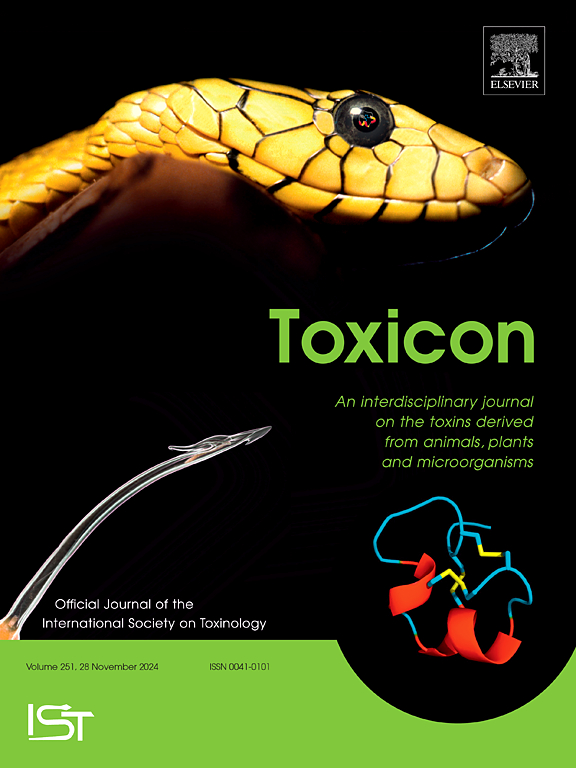生物分析方法、生物可及性和健康风险评估背景下新出现的真菌毒素Enniatins和Beauvericin的毒性动力学综述。
IF 2.6
4区 医学
Q2 PHARMACOLOGY & PHARMACY
引用次数: 0
摘要
真菌毒素是真菌产生的有毒次生代谢物,经常污染农产品,对人类和动物健康构成风险。其中,enniatins (ENNs)和beauvericin (BEA)因其在食品和饲料产品中的广泛存在及其潜在的毒性作用而受到关注。本文综述了检测生物基质中ENNs和BEA的生物分析方法,重点介绍了液相色谱-质谱法(LC-MS/MS)、固相萃取法(SPE)和先进的样品制备技术。它强调了评估生物可及性、确定消化过程中真菌毒素吸收比例及其相关暴露风险的重要性。本综述还探讨了ENNs和BEA的毒性动力学特征,提供了它们在人类和动物中的吸收、分布、代谢和排泄(ADME)的见解。这篇综述还探讨了这些真菌毒素的生物转化,揭示了它们代谢成各种产品的过程。讨论了生物监测研究,重点是检测生物液体(如尿液、血浆和组织)中ENNs和BEA的代谢物,以评估暴露。综上所述,本文主张加强对ENNs和BEA的毒性动力学和生物转化的研究,以充分了解其健康风险,并呼吁加强生物分析检测和生物监测方法,以改善食品安全和监管措施。本文章由计算机程序翻译,如有差异,请以英文原文为准。

A review of bioanalytical methods, bioaccessibility, and toxicokinetics of emerging mycotoxins enniatins and beauvericin in the context of health risk assessment
Mycotoxins, toxic secondary metabolites produced by fungi, often contaminate agricultural products, posing risks to human and animal health. Among these, enniatins (ENNs) and beauvericin (BEA) have gained attention due to their widespread occurrence in food and feed products and their potential toxic effects. This review comprehensively examines bioanalytical methods for detecting ENNs and BEA in biological matrices, focusing on liquid chromatography-mass spectrometry (LC-MS/MS), solid-phase extraction (SPE), and advanced sample preparation techniques. It emphasizes the significance of assessing bioaccessibility, determining the proportion of mycotoxins absorbed during digestion and their associated exposure risk. The review also explores the toxicokinetic profiles of ENNs and BEA, providing insights into their absorption, distribution, metabolism, and excretion (ADME) in humans and animals. The review also explores the biotransformation of these mycotoxins, shedding light on their metabolism into various products. Biomonitoring studies are discussed, focusing on detecting the metabolites of ENNs and BEA in biological fluids such as urine, plasma, and tissues to assess exposure. Overall, this review advocates for more research on toxicokinetics and biotransformation to fully understand the health risks of ENNs and BEA, and calls for enhanced bioanalytical detection and biomonitoring methods to improve food safety and regulatory measures.
求助全文
通过发布文献求助,成功后即可免费获取论文全文。
去求助
来源期刊

Toxicon
医学-毒理学
CiteScore
4.80
自引率
10.70%
发文量
358
审稿时长
68 days
期刊介绍:
Toxicon has an open access mirror Toxicon: X, sharing the same aims and scope, editorial team, submission system and rigorous peer review. An introductory offer Toxicon: X - full waiver of the Open Access fee.
Toxicon''s "aims and scope" are to publish:
-articles containing the results of original research on problems related to toxins derived from animals, plants and microorganisms
-papers on novel findings related to the chemical, pharmacological, toxicological, and immunological properties of natural toxins
-molecular biological studies of toxins and other genes from poisonous and venomous organisms that advance understanding of the role or function of toxins
-clinical observations on poisoning and envenoming where a new therapeutic principle has been proposed or a decidedly superior clinical result has been obtained.
-material on the use of toxins as tools in studying biological processes and material on subjects related to venom and antivenom problems.
-articles on the translational application of toxins, for example as drugs and insecticides
-epidemiological studies on envenoming or poisoning, so long as they highlight a previously unrecognised medical problem or provide insight into the prevention or medical treatment of envenoming or poisoning. Retrospective surveys of hospital records, especially those lacking species identification, will not be considered for publication. Properly designed prospective community-based surveys are strongly encouraged.
-articles describing well-known activities of venoms, such as antibacterial, anticancer, and analgesic activities of arachnid venoms, without any attempt to define the mechanism of action or purify the active component, will not be considered for publication in Toxicon.
-review articles on problems related to toxinology.
To encourage the exchange of ideas, sections of the journal may be devoted to Short Communications, Letters to the Editor and activities of the affiliated societies.
 求助内容:
求助内容: 应助结果提醒方式:
应助结果提醒方式:


